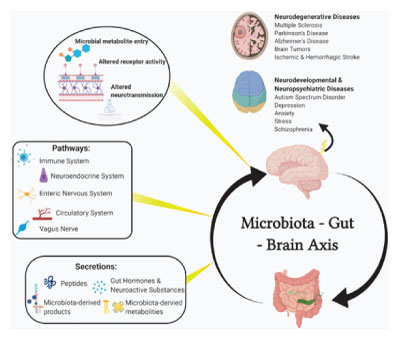The human gut is being recognized as a second brain, serving the body for optimal physical and mental health. Obesity and its associated complexities are major health concerns in the modern era. The objective of this editorial was, therefore, to present a novel theory that regular intense aerobic exercise (RIAE) can prevent obesity, cancer and neural diseases via a gut–brained mechanism [1]. While the gut–brain phrase represents the neural and endocrinological connections of the gut and brain, the innovative phrase “gut–brained” describes a 1) gut–centered or gut–originated mechanism that is 2) brain–mediated. Thus, it carries the meaning of the two phrases with more emphasis on the original role of the gut and underlines the fact that the gut is a second brain for a postmodern human. Exercise enhances metabolism not only in terms of energy consumption but also by facilitating nutrient assimilation and excretion via the gut. It is postulated that during such exercises, the human gut moves and performs more regularly and optimally towards healthy nutrient assimilation and waste management. These would occur notably via gut–brain connection mechanisms apart from direct impacts on gut or microbiome physiology per se. Accordingly, such nearly optimal physiological effects would remain active during non–exercise circadian periods if physical activity would be intense enough and regular (e.g., daily or at least weekly).
Regular Intense Aerobic Exercises (RIAE) such as running, swimming, and climbing are considered effective and stimulatory in optimizing gut physiology and health. It is also synthesized that RIAE would strengthen splanchnic tissues’ performance and would prevent, or at the very least, minimize visceral adiposity. This mechanism would refresh and empower the gut–oriented mechanisms controlling appetite through the brain. In other words, should RIAE persist, satiety signals would work timely and durably, thereby, reducing the likelihood of overeating and obesity. This cascade would imply nearly optimized appetite and eating patterns over the circadian periods.
Moreover, with RIAE, regular defecation would sustain and constipation would not likely occur. Constipation commonly occurs when waste or stool moves very slowly through the gastrointestinal tract. Thus, waste may not be eliminated effectively from the rectum that could make the stool dry and hard [1,2]. The overly increased hardness of digesta or excreta as well as impaired gut–brain connections would not be healthy for normal gut physiology. These neural and biochemical disturbances in the gut–brain connection networks are thought to increase the risk of gut–brain related issues and cancers [1,3,4]. The neuro–connections between the gut–microbiota and brain and their endocrinological governance of the human biochemistry are increasingly being recognized (Figure 1) [3,4].

Figure 1: An example summary of the gut (microbiata)–brain axis and the governing neuro–conections [4]. Regular intense aerobic exercise (RIAE) could help optimize appetite and prevent obesity, cancer, and neurological diaseses through such related known [4] and unknown mechanisms.
To summarize pragmatically, Regular Intense Aerobic Exercise (RIAE) should be accommodated thoughtfully in the modern human’s lifestyle. The known and unknown theorized gut–brained and gut–brain networks would be maninly responsible for the enhanced gut and splanchnic immunity and function as well as optimized appetite and eating patterns over the circadian periods. Future research could shed more light on various aspects of this theory (presented herein) by monitoring the short– and long–term metabolic and health impacts of RIAE in people of different ages.
Nature for its inspirational nature.
Author declares that there is no conflict of interest.